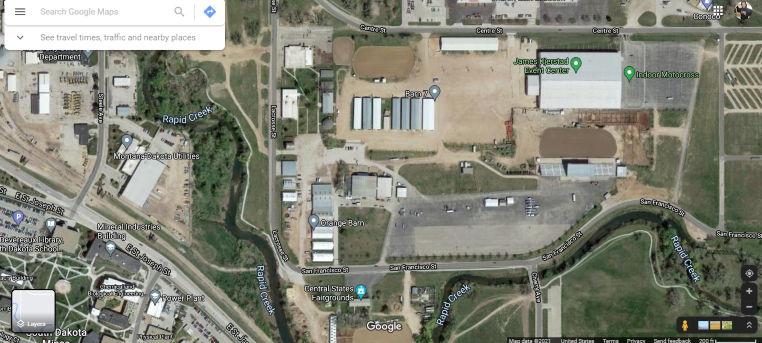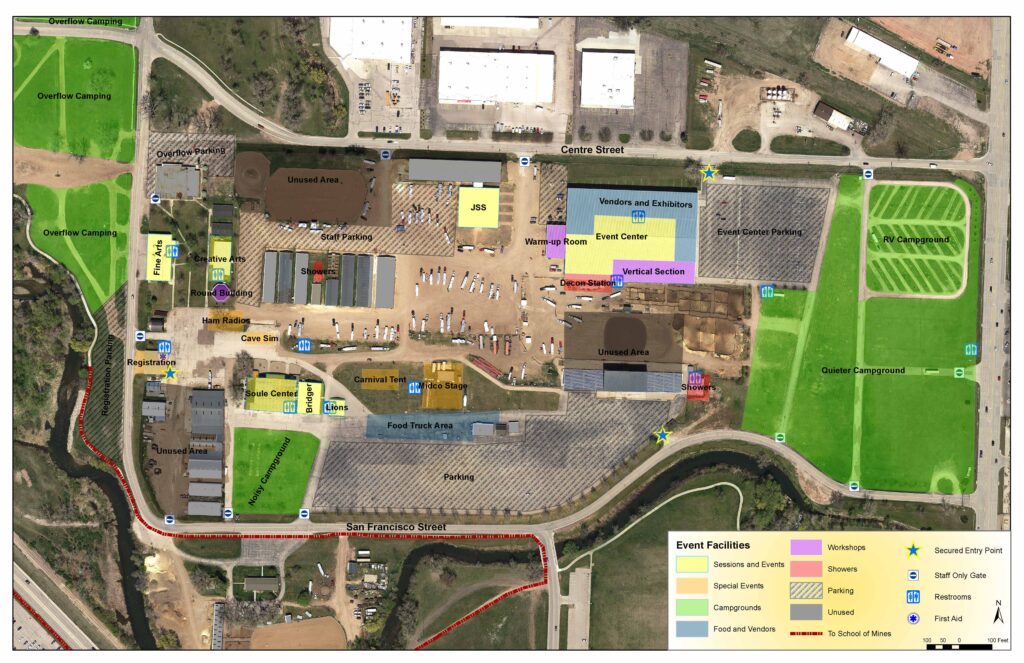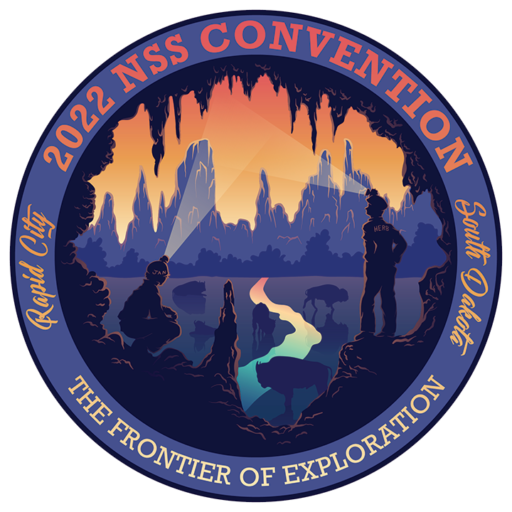The 2022 NSS Convention will be held in Rapid City, South Dakota at the Central States Fairgrounds (800 San Francisco Street). The Fairgrounds has all of the amenities for the convention – plenty of climate-controlled classrooms and exhibit space, a large banquet hall, campground with limited RV hookups, a stage for evening bands to play, and of course an arena with grandstands for the speleolympics!
Surrounded by the Black Hills National Forest, one of the largest state parks in the nation, and some of the most iconic scenery and attractions in the western United States, the Convention site is situated in a central location for attendees to experience all the Black Hills has to offer. Less than an hour from the fairgrounds you will find the granite needles, the cathedral spires, and of course Mount Rushmore. And yes, there are caves too! Two of the longest caves in the world, Jewel and Wind Cave are both a one hour drive away. With over 360 miles of passage between them, these two caves are not to be missed. Also, the Dahm Springs Preserve, an NSS-owned cave preserve on the outskirts of Rapid City, is only a short drive away. The Monday night Howdy Party will be held at Rush Mountain Adventure Park, home to Rushmore Cave.
Getting To and From Convention
Rapid City sits along Interstate 90, a major East-West highway that makes getting to and from by vehicle fairly easy if you’re traveling from any place around the country. Additionally, several major airlines fly into Rapid City Regional Airport, just a short drive from the Fairgrounds. Several rental car companies are based at the airport, and Rapid City also has other transportation options such as Rapid Ride and Uber. Note that flying into Rapid City can often be fairly expensive. Some locals prefer to fly into and out of Denver International Airport, about a 6-hour drive from Rapid City. If you plan to take advantage of all that the Black Hills area has to offer, however, we highly recommend having your own vehicle available to explore the area. The Black Hills are fairly small geographically, but it still takes about an hour to get to some places from the Fairgrounds, and there’s a lot to see! Parking is plentiful at the convention site. You may carpool if you wish, or bring your own rig.
.

Click on the link below to explore the area around the Fairgrounds for hotels, restaurants, and local attractions.
Map of Central States Fairgrounds

To download a high resolution PDF of the of the map, please use this link (updated 6/11/2022):
https://nss2022.caves.org/wp-content/uploads/2022/06/2022_Final_SiteMap.pdf
For a map of the South Dakota School of Mines and Technology campus, please use this link:
https://nss2022.caves.org/wp-content/uploads/2022/05/Mines%20Map.pdf
Local Attractions – Parks, Monuments, and Forests
From the four faces carved high on Mount Rushmore and the Cathedral Spires of Custer State Park to the wondrous caverns of Wind Cave, from the otherworldly Badlands in the east to Devils Tower in the west – the Black Hills are home to many truly monumental places.
But that’s only some of what you’ll find here. With over five million acres of forest and mountain lands – an oasis in a sea of prairie – in the Black Hills you’ll also find rich western history, abundant natural beauty and meaningful adventure.
Mount Rushmore National Memorial
Majestic figures of George Washington, Thomas Jefferson, Theodore Roosevelt and Abraham Lincoln, surrounded by the beauty of the Black Hills of South Dakota, tell the story of the birth, growth, development and preservation of this country. From the history of the first inhabitants to the diversity of America today, Mount Rushmore brings visitors face to face with the rich heritage we all share
The Memorial is located near Keystone in the Black Hills of South Dakota, roughly 30 miles from Rapid City.
Each year, approximately three million tourists from all over the world visit Mount Rushmore to experience this patriotic site. Today, the wonder of the mountain reverberates through every visitor. The four “great faces” of the presidents tower 5,725 feet above sea level and are scaled to men who would stand 465 feet tall.
There are many amenities at the site including the Mount Rushmore Audio Tour, Lincoln Borglum Visitor Center & Museum, the Presidential Trail, Youth Exploration Area, Sculptor’s Studio, a parking garage with R.V. parking, pet exercise areas, , the Carvers Café, Memorial Ice Cream Shop, Gift Shop and the Mount Rushmore Bookstores.
Wind Cave National Park
Over many years of exploration and mapping, Wind Cave has grown to be one of the world’s largest known caves. Currently, over 150 miles of passages have been mapped making it the third-longest cave in the U.S. and the sixth-longest cave in the world. Wind Cave has few stalactites and stalagmites, but many unusual formations and a variety of minerals are found in the cave. The cave is well known for its outstanding display of boxwork, an unusual cave formation composed of thin calcite fins resembling honeycombs.
Along with this massive cave, Wind Cave National Park also features 28,295 acres of mixed-grass prairie, Ponderosa pine forest and wildlife. The park’s mixed-grass prairie is one of the few remaining and is home to native wildlife such as bison, elk, pronghorn, mule deer, coyotes and prairie dogs.
Jewel Cave National Monument
Beneath the Black Hills of South Dakota is the intriguing underground world of Jewel Cave. With over 202 miles of explored passageways, Jewel Cave ranks as one of the longest caves in the world. The cave was discovered at the turn of the century by brothers passing through Hell Canyon.
This underground environment can satiate even the most curious of humans. Brilliant color and fragile rocks reveal an amazing ecosystem not visible anywhere else. The third longest cave in the world has much to offer to a wide range of those interested in its natural glory. The monument is also home to a variety of plants and animals and has a fascinating wildfire history. This resource is truly a jewel in the National Park Service.
Guided cave tours provide opportunities for viewing this pristine cave system. Jewel Cave is a unique world of sparkling calcite crystals, delicate strands of gypsum, and other spectacular cave formations. It contains large rooms strewn with boulders, tight crawlways, and dark fissures leading into the unknown.
Crazy Horse Memorial
A Lakota Sioux warrior, a famed artist, his family and a canvas composed of granite are the elements that comprise the legendary past, present and future of the Crazy Horse Memorial.
Sculptor Korczak Ziolkowski began the world’s largest mountain carving in 1948. Members of his family and their supporters are continuing his artistic intent to create a massive statue that will be 641 feet long and 563 feet high. To give that some perspective, the heads at Mount Rushmore National Memorial are each 60 feet high. Workers completed the carved 87½-foot-tall Crazy Horse face in 1998, and have since focused on thinning the remaining mountain to form the 219-foot-high horse’s head.
Crazy Horse Memorial hosts between 1 and 1½ million visitors a year. The number of foreign travelers, particularly group tours from Asia, is increasing.
The Indian Museum of North America, and the adjoining Welcome Center and Native American Educational and Cultural Center, feature more than 12,000 contemporary and historic items, from pre-Colombian to contemporary times. The new Mountain Museum wing helps explain the work behind the scenes, augmenting the introductory “Dynamite & Dreams” movie at the Welcome Center.
Crazy Horse Memorial is open every day, from 8 a.m. to dark during the summer season. Memorial Day weekend through the end of September, the storytelling continues each night at dark with the “Legends in Light” laser-light show projected on the mountain carving.
Custer State Park
Custer State Park is famous for its bison herds, other wildlife, scenic drives, historic sites, visitor centers, fishing lakes, resorts, campgrounds and interpretive programs. In fact, it was named as one of the World’s Top Ten Wildlife Destinations for the array of wildlife within the park’s borders and for the unbelievable access visitors have to them.
One of the nation’s largest state parks, just 15 miles from the city of Custer, South Dakota’s premier State Park comprises 71,000 acres.
Custer State Park has been home to diverse cultural heritages for thousands of years and has provided an array of scenic beauty and outdoor recreation for visitors since the early 1900s.
Badlands National Park
The Lakota gave this land its name, “Mako Sica,” meaning “land bad.” Located in southwestern South Dakota, Badlands National Park consists of 244,000 acres of sharply eroded buttes, pinnacles and spires blended with the largest protected mixed grass prairie in the United States. It is desolation at its truest, where you can look for miles and see no sign of civilization.
This land has been so ruthlessly ravaged by wind and water that it has become picturesque. The Badlands are a wonderland of bizarre, colorful spires and pinnacles, massive buttes and deep gorges. Erosion of the Badlands reveals sedimentary layers of different colors: purple and yellow (shale), tan and gray (sand and gravel), red and orange (iron oxides) and white (volcanic ash).
Badlands National Park also preserves the world’s greatest fossil beds of animals from the Oligocene Epoch of the Age of Mammals. The skeletons of ancient camels, three-toed horses, saber-toothed cats and giant rhinoceros-like creatures are among the many fossilized species found here. All fossils, rocks, plants and animals are protected and must remain where you find them. Prehistoric bones are still being uncovered today by park officials.
Come enjoy this park’s biological diversity. The Badlands are home to the largest mixed grass prairie in the National Park System and is surrounded by the Buffalo Gap National Grassland. Wildlife roams the park’s boundaries as well. Bison, pronghorn, mule and whitetail deer, prairie dogs, coyotes, butterflies, turtles, snakes, bluebirds, vultures, eagles and hawks are just some of the wildlife that can often be seen by visitors. In 1994, the near-extinct Black-footed ferrets were reintroduced into the Badlands prairie. These nocturnal animals are rarely seen by the visiting public.
Devils Tower National Monument
Devils Tower National Monument, a unique and striking geologic wonder steeped in Native American legend, is a modern-day national park and climbers’ challenge. Devils Tower sits across the state line in northeast Wyoming. The Tower is a solitary, stump-shaped granite formation that looms 1,267 feet above the tree-lined Belle Fourche River Valley, like a skyscraper in the country. Once hidden below the earth’s surface, erosion has stripped away the softer rock layers revealing the Tower.
The two-square-mile park surrounding the tower was proclaimed the nation’s first national monument by President Theodore Roosevelt in 1906. The park is covered with pine forests, woodlands, and grasslands. While visiting the park you are bound to see deer, prairie dogs, and other wildlife. The mountain’s markings are the basis for Native American legend. One legend has it that a giant bear clawed the grooves into the mountainside while chasing several young Indian maidens. Known by several northern plains tribes as Bears Lodge, it is a sacred site of worship for many American Indians. Devils Tower is also remembered as the movie location for “Close Encounters of the Third Kind.”
The stone pillar is about 1,000 feet in diameter at the bottom and 275 feet at the top and that makes it the premier rock climbing challenge in the Black Hills. Hikers enjoy the Monument’s trails. The 1.25-mile Tower Trail encircles the base. This self-guided hike offers close-up views of the forest and wildlife, not to mention spectacular views of the Tower itself. The Red Beds Trail covers a much wider three-mile loop around the tower.
Black Hills National Forest
resident Grover Cleveland established the Black Hills National Forest in 1897 as the Black Hills Forest Reserve. Now in its second century, the USDA Forest Service manages these 1.2 million acres of public lands for a diversity of wildlife and fish, recreation, water production, livestock grazing, timber harvesting, wilderness, and other uses.
The timbered mountains of the Black Hills National Forest continue 10 to 40 miles beyond the South Dakota border, west into Wyoming and covers an area that is about 125 miles long and 65 miles wide. Visitors will find rugged rock formations, canyons, grasslands, streams, lakes, and unique caves. Recreational opportunities for visitors include 11 reservoirs, multiple swimming beaches, 30 campgrounds, two scenic byways, 1,300 miles of streams, 13,605 acres of wilderness, over 450 miles of hiking trails, and much more.
The name “Black Hills” comes from the Lakota words Paha Sapa, which mean “hills that are black.” From a distance, these pine-covered hills, rising several thousand feet above the surrounding prairie, appear to be black. The Hills are diverse in cultural heritage. The earliest known use of the area occurred about 10,000 years ago. Later, Native Americans came to the Black Hills to seek visions and to purify themselves. Paha Sapa was considered a sanctuary and was a peaceful meeting ground for tribes at war. Exploration of the Black Hills by fur traders and trappers occurred in the 1840s. In 1874, General George A. Custer led an Army exploration into the area and discovered gold along French Creek in the Southern Hills. The discovery of gold in the Black Hills caused an excitement across the country and gold seekers and settlers soon followed. When word got out of the discovery of gold in the Black Hills, settlers soon followed.
Minute Man National Historic Site
Remember fallout shelters, Sputnik, and the missile gap? Remember duck-and cover-drills, the Iron Curtain, the Red Scare and first-strike capability? The deadly drama underlying the Cold War is relived at Minuteman Missile National Historic Site near Wall where visitors can see how the end of the world could have begun. The site is the first national park in the world dedicated to commemorating the events of the Cold War. Two 1960’s era Intercontinental Ballistic Missile (ICBM) sites have been preserved for public viewing. Delta-09, an underground missile silo on the edge of Badlands National Park, held a Minuteman II missile that could send a nuclear weapon to the Soviet Union in 30 minutes. Delta-01 control center includes the topside support building and the underground control center capsule.
Visitors have the opportunity to enjoy a ranger-guided tour of Delta-01, located at I-90 exit 127. Tours are by reservation only and limited to 6 people per tour. Self-guided tours are available at Delta-09 missile silo, located at I-90 Exit 116. The visitor center is located at I-90 exit 131 and features exhibits that allow visitors to explore Minuteman’s role in the Cold War. A new park film will make a debut in 2017.
